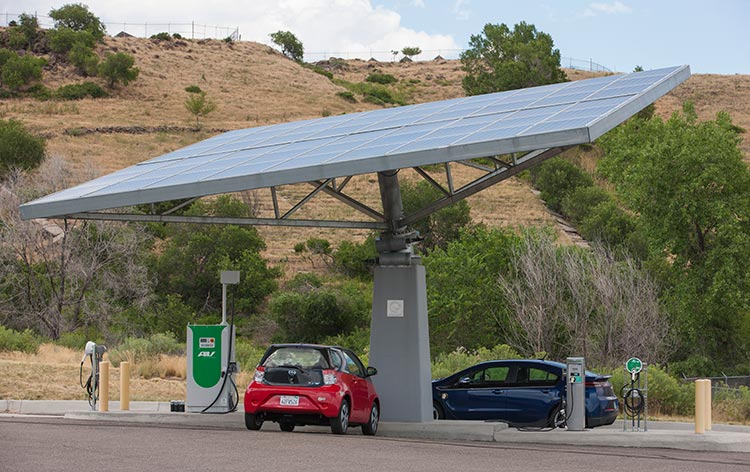REopt Evaluates Electric Vehicle Charging Stations for the Vehicle Technologies Office

Vehicles parked under a solar canopy are charged with PV-generated electricity. NREL
is using the REopt model to help reduce operating costs of electric vehicle charging
stations. Photo by Matthew Staver, NREL 39246
NREL, in collaboration with the U.S. Department of Energy Vehicle Technologies Office and Idaho National Laboratory, used the REopt® model to evaluate solutions to reduce operating costs of electric vehicle DC fast charging (DCFC) stations. Technical solutions considered included coupling DCFC stations with energy storage and distributed solar photovoltaic (PV) generation and colocating them behind the meter of an existing commercial load.
NREL used REopt to evaluate more than 10,000 unique solar resource and utility rate combinations, which included 7,336 rates from 2,172 utility territories. Results show that the cost of electricity for DCFC stations varies dramatically, from less than $0.10 to over $2 when levelized on a per kilowatt-hour basis. In particular, electricity demand charges are shown to significantly impact electricity cost for DCFC, especially for low utilization levels. Electricity cost decreases rapidly as DCFC station use increases. These scenarios included varying DCFC loads and PV and storage combinations.
The study found that colocation is almost always economically viable to mitigate fixed cost and demand charges but that the absolute cost savings diminished with larger, highly utilized DCFC stations. PV and storage deployment can address high energy and/or demand cost tariffs, reducing the overall cost of delivering DCFC services. PV systems alone mitigate energy cost, even in areas with relatively low solar irradiance. Energy storage alone mitigates demand charges and is more effective for “peaky” or low-utilization loads. PV and energy storage can deploy synergistically to provide cost reductions for DCFC, leveraging their ability to mitigate demand and energy charges.
In general, technology solutions are shown to effectively reduce electricity cost for DCFC at locations with high energy and/or demand charges, reducing overall average cost of electricity for DCFC applications. This study can be used to inform the design and deployment of DCFC stations, especially during the early stages of electric vehicle charging infrastructure rollout.
Related Stories
Applied Energy article: Technology Solutions To Mitigate Electricity Cost for Electric Vehicle DC Fast Charging
Sponsors
Department of Energy Vehicle Technologies Office
Key Partners
Idaho National Laboratory
Contact
Share